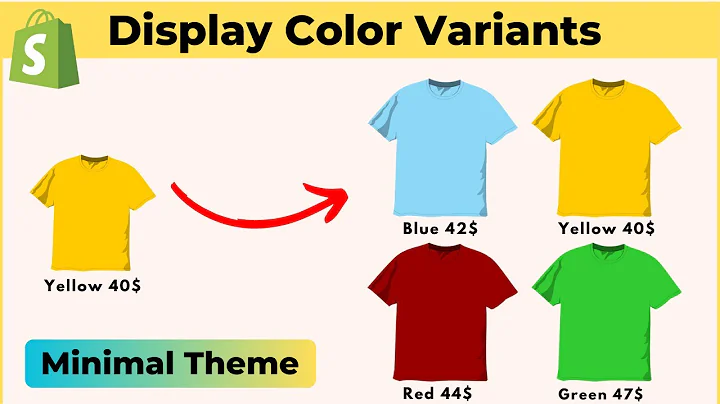Maximize Your Shopify Store's Performance with Insights
Table of Contents
- Introduction
- Understanding Shopify Reports
- 2.1 Shopify Analytics
- 2.2 Types of Reports
- 2.3 Differences Based on Shopify Plan
- Navigating the Shopify Reports Dashboard
- 3.1 Overview of the Dashboards
- 3.2 Time Frame and Comparison
- 3.3 Quick Health Overview
- Exploring Different Report Categories
- 4.1 General Sale Reports
- 4.2 Sales by Coupon
- 4.3 Sales by SKU
- 4.4 Sales by Location
- 4.5 Sales by Currency
- 4.6 Acquisition Reports
- 4.7 Customer Reports
- 4.8 Profit Margin Reports
- 4.9 Retail Sales Reports
- 4.10 Behavior Reports
- 4.11 Inventory Reports
- 4.12 Marketing Reports
- 4.13 Custom Reports
- Utilizing Insights for Data-driven Decisions
- 5.1 Time Frame Selection
- 5.2 Product Insights
- 5.3 Trending Products
- 5.4 Products to Improve
- 5.5 Frequently Abandoned Products
- Real-time Monitoring with Live View
- 6.1 Live View Overview
- 6.2 Monitoring Active Shopping Carts
- 6.3 Tracking Checkouts and Purchases
- 6.4 Ensuring Smooth Operations during Promotions
- Conclusion
Understanding Shopify Reports: A Comprehensive Guide
Shopify Reports, also known as Shopify analytics, provide valuable insights into the performance of your online store. This guide will take you through the different types of reports available, how to navigate the Shopify Reports dashboard, and highlight the significance of insights for data-driven decision making. We will also explore the Live View feature for real-time monitoring of your store's activities.
1. Introduction
As an online store owner, understanding the performance of your business is crucial for growth and success. Shopify Reports offer a comprehensive analysis of various metrics, helping you identify trends, make informed decisions, and optimize your store's performance. Whether you're looking to track sales, monitor customer behavior, or evaluate marketing efforts, Shopify Reports provide valuable data to guide your strategic planning.
2. Understanding Shopify Reports
2.1 Shopify Analytics
Shopify Reports, also referred to as Shopify analytics, are a collection of data-driven reports that provide insights into various aspects of your online store's performance. These reports cover metrics such as sales, customer behavior, acquisition channels, inventory management, and more. By analyzing these reports, you can gain a deeper understanding of your store's strengths and areas for improvement.
2.2 Types of Reports
Shopify offers a wide range of reports, each focusing on a specific aspect of your online store's performance. These reports include:
- General Sale Reports: Provides an overview of sales performance, including sales by coupon, SKU, location, and currency.
- Acquisition Reports: Tracks how customers are acquired, such as through Facebook ads, Google search, or other marketing channels.
- Customer Reports: Analyzes customer behavior, including first-time versus returning customers and the frequency of customer visits.
- Profit Margin Reports: Offers insights into the profitability of your products by considering costs and sales data.
- Retail Sales Reports: Provides financial data related to sales, payments, taxes, and other retail-related metrics.
- Behavior Reports: Tracks customer actions on your website, such as session duration, store searches, and abandoned products.
- Inventory Reports: Helps manage inventory by providing data on stock levels, product availability, and sales.
- Marketing Reports: Evaluates the effectiveness of your marketing efforts, including ad performance and traffic sources.
- Custom Reports: Allows you to create personalized reports based on specific criteria and metrics relevant to your business.
2.3 Differences Based on Shopify Plan
The availability and extent of Shopify Reports vary depending on the plan you choose. Higher-tier plans, such as the advanced Shopify plan, provide access to a broader range of reports compared to lower-tier plans like the lite version. It's important to consider your specific business needs and choose a plan that offers the necessary reports and insights to help you make informed decisions.
3. Navigating the Shopify Reports Dashboard
3.1 Overview of the Dashboards
Upon accessing Shopify Reports, you will be greeted with the Dashboards page. This feature offers quick access to essential reports, providing an overview of your store's health and performance. Dashboards consist of widgets or boxes that display key metrics such as total sales, online sessions, conversion rates, and more. By glancing at these widgets, you can quickly assess your store's performance at a high level.
3.2 Time Frame and Comparison
Within the Dashboards page, you can customize the time frame of the data displayed. By selecting a specific time frame, such as a month or a week, you can focus on a particular period of interest. Additionally, you can compare your selected time frame to a previous period, allowing you to identify trends, growth, or declines. This comparison provides valuable insights into the performance of your store over time.
3.3 Quick Health Overview
Dashboards offer a snapshot of your store's health and performance through various widgets. These widgets represent key metrics such as total sales, online sessions, conversion rates, and customer returning rates. By hovering over the widgets, you can gain more specific information about each metric and dive deeper into the corresponding reports. Dashboards serve as a go-to resource for quickly assessing the overall health and performance of your online store.
4. Exploring Different Report Categories
Shopify Reports are categorized based on their focus and purpose. By exploring these report categories, you can gain a comprehensive understanding of your store's performance and make data-driven decisions.
4.1 General Sale Reports
General Sale Reports provide insights into various aspects of sales performance. These reports include sales by coupon, SKU, product, variant, location, and currency. Analyzing these reports allows you to identify the most successful coupon codes, top-selling products, and the geographical distribution of your customers.
4.2 Sales by Coupon
Sales by Coupon reports focus on analyzing the performance of different coupon codes. By understanding which coupon codes are frequently used by customers, you can optimize your promotional strategies and tailor discounts to specific customer segments.
4.3 Sales by SKU
Sales by SKU reports provide a detailed analysis of sales performance based on specific stock-keeping units (SKUs). These reports help you identify which product variants or SKUs are driving the most sales and make informed decisions regarding inventory management and product promotions.
4.4 Sales by Location
Sales by Location reports offer insights into regional sales performance. By understanding which locations generate the highest sales, you can tailor marketing campaigns, optimize shipping strategies, and expand your customer base in target markets.
4.5 Sales by Currency
Sales by Currency reports provide information on sales performance in different currencies. These reports are particularly useful for businesses operating in multiple countries or targeting international customers. By analyzing sales by currency, you can uncover trends and adjust pricing strategies accordingly.
4.6 Acquisition Reports
Acquisition Reports track how customers discover and interact with your online store. These reports help you understand the effectiveness of your marketing efforts and identify the most successful acquisition channels. Key acquisition reports include data on channels such as social media ads, search engines, referrals, and direct traffic.
4.7 Customer Reports
Customer Reports focus on understanding customer behavior and preferences. These reports provide insights into metrics such as customer visits, conversion rates, and the frequency of returning customers. By analyzing these reports, you can identify customer engagement patterns, determine customer loyalty, and optimize your marketing strategies.
4.8 Profit Margin Reports
Profit Margin Reports offer valuable insights into the profitability of your products. By considering costs and sales data, these reports help you understand the profit margins of individual products or product categories. Understanding profit margins enables you to make informed pricing decisions, manage inventory effectively, and identify opportunities for cost optimization.
4.9 Retail Sales Reports
Retail Sales Reports provide financial data related to sales, payments, taxes, and other retail-specific metrics. These reports help you manage finances, track retail sales performance, and ensure compliance with tax obligations. By analyzing these reports, you can gain a comprehensive overview of your store's financial health.
4.10 Behavior Reports
Behavior Reports track customer actions on your online store. They provide insights into metrics such as session duration, store searches, abandoned products, and real-time pageviews. By understanding how customers interact with your store, you can optimize the user experience, identify pain points, and improve conversion rates.
4.11 Inventory Reports
Inventory Reports focus on managing inventory effectively. These reports provide insights into stock levels, product availability, and sales performance. By analyzing inventory reports, you can identify fast-selling products, identify low-stock situations, and make data-driven decisions for inventory management and restocking.
4.12 Marketing Reports
Marketing Reports help evaluate the effectiveness of your marketing efforts and campaigns. These reports track metrics such as ad performance, traffic sources, and campaign reach. By understanding which marketing channels drive the most traffic and conversions, you can optimize your marketing strategies, allocate resources effectively, and maximize your return on investment.
4.13 Custom Reports
Custom Reports allow you to create personalized reports based on your specific business needs and metrics of interest. By customizing reports, you can focus on key performance indicators that are relevant to your business and gain deeper insights into specific aspects of your online store's performance.
5. Utilizing Insights for Data-driven Decisions
Insights within the Shopify Reports provide actionable data to make informed decisions and optimize your online store's performance. By analyzing these insights, you can identify trends, capitalize on opportunities, and address areas that need improvement.
5.1 Time Frame Selection
When utilizing insights, it is important to select the appropriate time frame for analysis. This allows you to focus on specific periods of interest, such as recent trends or seasonal fluctuations. By analyzing performance within a designated time frame, you can gain a comprehensive understanding of your store's performance and make data-driven decisions accordingly.
5.2 Product Insights
Product Insights provide information on various aspects of product performance, including sales, discounts, and promotional opportunities. By understanding which products are performing well and which ones need improvement, you can optimize your product lineup, adjust pricing strategies, and identify potential areas for growth.
5.3 Trending Products
Trending Products highlight items that are experiencing growth in sales or garnering increased customer interest. By capitalizing on these trending products, you can optimize your marketing efforts, allocate resources effectively, and potentially expand your product offerings in related categories.
5.4 Products to Improve
Products to Improve insights identify items that receive significant customer attention but fail to convert into sales. By addressing the potential barriers to purchase for these products, such as pricing, product descriptions, or customer trust, you can enhance their appeal and increase conversion rates.
5.5 Frequently Abandoned Products
Frequently Abandoned Products insights reveal items that are commonly added to carts but not purchased. By analyzing the reasons for cart abandonment, such as high shipping costs, lengthy checkout processes, or lack of trust indicators, you can optimize the shopping experience, reduce cart abandonment rates, and improve overall conversion rates.
6. Real-time Monitoring with Live View
Live View is a feature that allows you to monitor your online store's activities in real time. By viewing active shopping carts, checkouts, and purchases, you can ensure smooth operations during promotions, identify any issues or bottlenecks, and offer immediate assistance to customers.
6.1 Live View Overview
Live View provides a real-time overview of your online store's activities for the past five minutes. It displays the number of visitors on your site, active shopping carts, and recent purchases. By checking Live View, you can verify that everything is functioning correctly, troubleshoot any issues, and ensure a seamless shopping experience for your customers.
6.2 Monitoring Active Shopping Carts
Active Shopping Carts in Live View allow you to see which customers have added items to their carts but have not yet completed their purchases. By identifying active shopping carts, you can send targeted offers or reminders to encourage customers to complete their transactions.
6.3 Tracking Checkouts and Purchases
Live View also enables you to track checkouts and purchases in real time. This allows you to see which customers are in the final stages of the purchasing process and monitor successful transactions. By tracking checkouts and purchases, you can gain insights into the conversion process and identify any potential issues that may arise.
6.4 Ensuring Smooth Operations during Promotions
Live View is particularly valuable during promotional events or high-traffic periods. By closely monitoring customer activities in real time, you can ensure smooth operations, promptly address any issues or bottlenecks, and offer exceptional customer support. Real-time monitoring empowers you to deliver a seamless shopping experience, thereby maximizing the effectiveness of your promotions.
7. Conclusion
Shopify Reports provide invaluable insights into the performance of your online store. By understanding and utilizing these reports effectively, you can make data-driven decisions, optimize marketing efforts, and drive growth for your business. Whether it's analyzing sales performance, tracking customer behavior, or monitoring real-time activity, Shopify Reports offer the tools and data necessary to thrive in the competitive e-commerce landscape.
Highlights
- Shopify Reports provide valuable insights into the performance of your online store.
- Different types of reports cover metrics such as sales, customer behavior, acquisition channels, and more.
- The Shopify Reports dashboard allows for quick health overviews and customizable time frames.
- Insights help make data-driven decisions by analyzing trends and identifying areas for improvement.
- Live View allows for real-time monitoring of shopping carts, checkouts, and purchases.
FAQ
Q: Can I customize and save my own reports in Shopify?
A: Yes, Shopify allows you to create custom reports based on your specific business needs. You can tailor the columns, filters, and time frames to focus on the metrics that matter most to your store. These custom reports can be saved for later access and analysis.
Q: How often is the data in Shopify Reports updated?
A: The data in Shopify Reports is updated in near real-time, allowing you to monitor and analyze the latest information about your store's performance. You can rely on up-to-date data when making decisions and assessing your store's health.
Q: Can I export the data from Shopify Reports for further analysis?
A: Yes, Shopify Reports offers the option to export data in CSV format. This allows you to download the data and analyze it using spreadsheet software such as Excel or Google Sheets. Exporting data provides flexibility in conducting more in-depth analysis and generating custom reports.
Q: Do I need a specific plan to access all the reports in Shopify?
A: The availability of reports in Shopify may vary depending on the plan you have. Higher-tier plans, such as the advanced Shopify plan, usually provide access to a broader range of reports compared to lower-tier plans. It's recommended to check the details of your plan to understand which reports are available to you.
Q: How can Shopify Reports help me improve my e-commerce business?
A: Shopify Reports offer valuable insights into various aspects of your store's performance. By analyzing sales data, customer behavior, and marketing metrics, you can identify trends, optimize your strategies, and make data-driven decisions to drive growth and improve overall business performance.






















